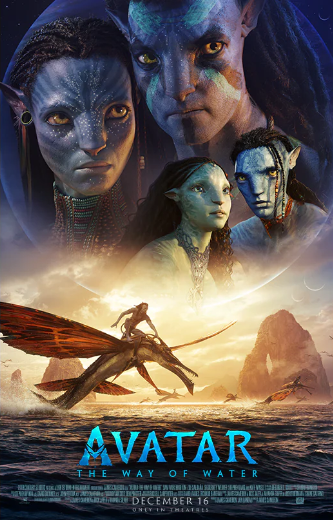
The Avatar: The Way of Water movie cover.
Warning: This article may contain spoilers.
Over a decade after Avatar swept the animated universe by storm, its long-awaited sequel finally arrived.
The first movie, released in 2009, had since risen to the top of the global chart of high-grossing films of all time with a collective gross of 2.92 billion at the box office and on streaming services.
As such, millions of movie-goers are familiar with the blue Na’vi species inhabiting the Pandora moon, whose crossover with humanity involved both war over the moon’s natural resources and romance between a Na’vi creature and a human—or human/Na’vi hybrid called an Avatar when entering Pandora—who would overpower his loyalty to his own species.
Now, in Avatar: The Way of Water, the journey continues with Neytiri, the Na’vi, and Jake Sully, the human-turned-Na’vi, where they have established a family together in Pandora. However, a familiar human threat resurfaces to take revenge on Jake for his betrayal, and they are forced to flee and adapt to a new life thousands of miles away from home.
Most of the movie chronicles this adaptation, from the family feeling ostracized on the new land to enduring familial challenges such as taking care of their kids. However, there is a drastic change in mood as the movie progresses. It is first lighthearted, but this lightheartedness is destroyed by the humans as they burn every Pandora island on their path, one by one, to locate the family. The two species face off in a new battle with the Na’vi, once again, having to protect their home from total destruction.
I enjoyed how the movie was not brimming with action throughout its entirety and took time to display the familial culture of the Na’vi people—how their caring for one another differed from that of humanity. The various languages, songs, and rituals—although completely fictional and only coming alive through the efforts of director James Cameron and other movie production workers—appeared fascinating to see performed so intricately on screen.
Additionally, the computer-generated imagery (CGI) stood out. As a mainstay of much of the movie’s praise, the creatures’ appearances and motions in Avatar: The Way of Water remained smooth, seamless, and lifelike like the prequel, but better as it reflects how animation greatly progressed throughout the decade. The impressive CGI definitely enhanced my 3D viewing experience in the theater.
On another note, it was also incredible when diving behind the scenes of the movie. Not only was CGI used to breathe life into the characters during scenes set underwater, but the filmmakers also used it for the actors to actually perform underwater. Beneath the weight of motion capture suits, the actors delivered a commendable performance that made the movie worth watching even more.
Ultimately, Avatar: The Way of Water is a must-watch for viewers who enjoyed the first movie, appreciate the genre of epic science fiction, or just want to see the CGI that many have acclaimed to be ahead of its time. It’s also breaking more gross records than ever before—especially with opening weekend reaching 435 million, and its overall box office currently exceeding 1.7 billion—already making it an iconic addition to the Avatar series and a must-watch movie for all.




